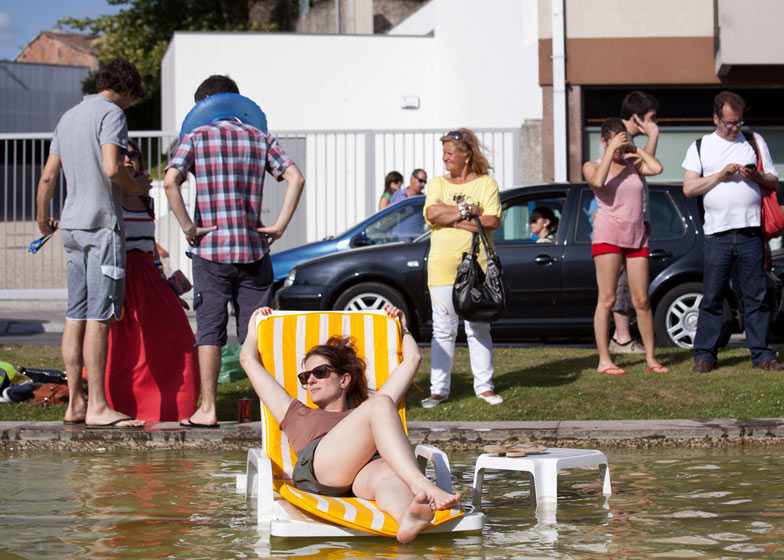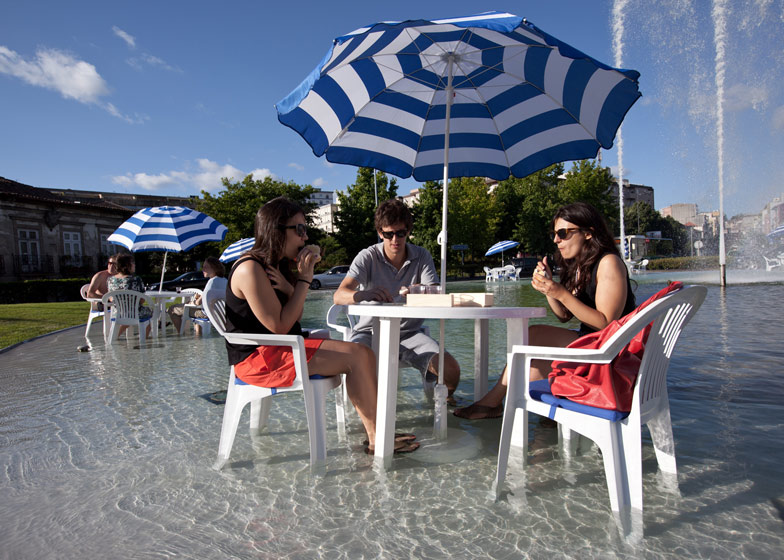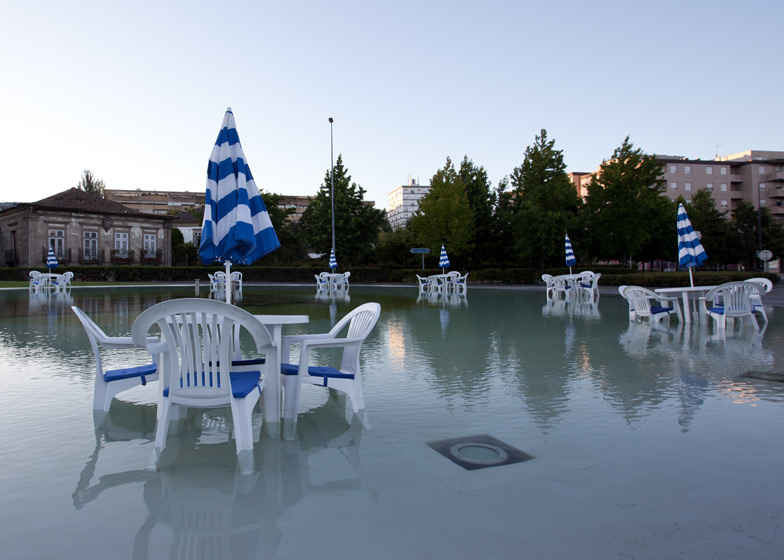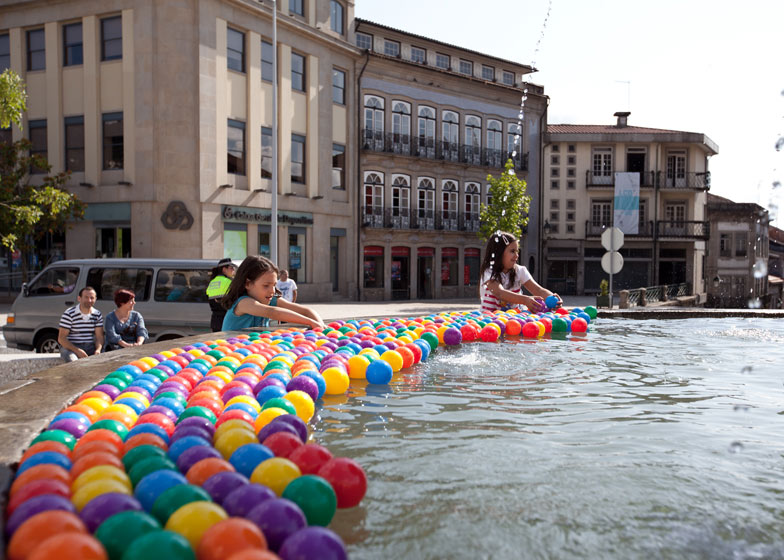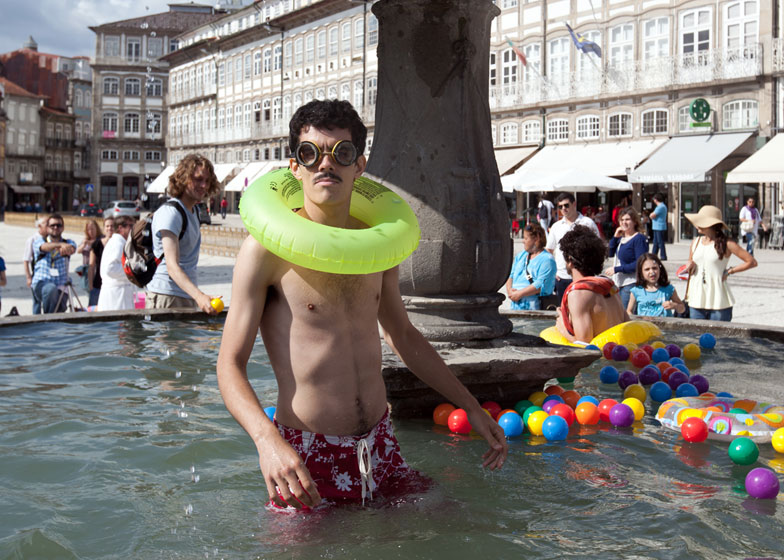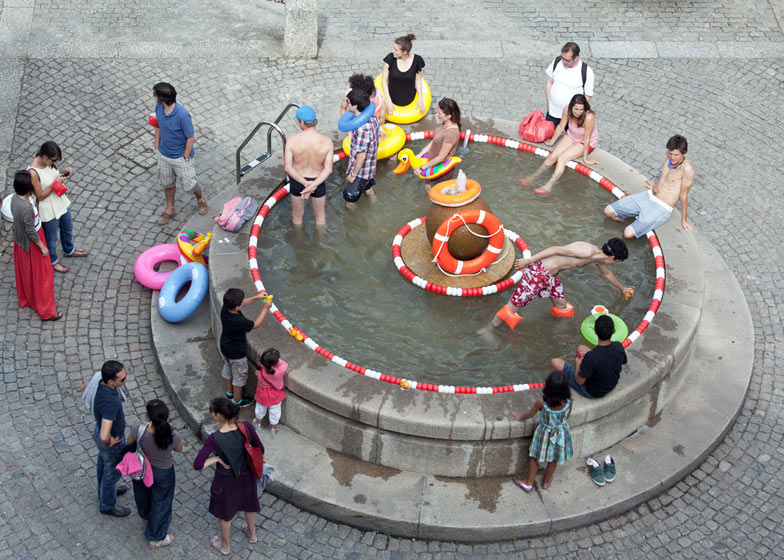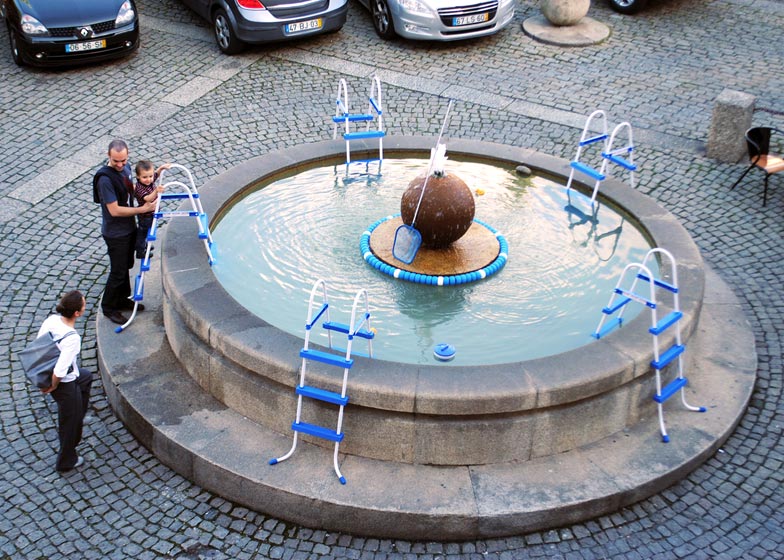Portugese studio LIKEarchitects and fashion designer Ricardo Dourado have used beach loungers, garden furniture and toys to get the people of Guimarães in Portugal paddling in the city's fountains (+ slideshow).
Yellow loungers are lined up inside one narrow fountain, while a deeper fountain can now be accessed by sets of swimming pool stairs.
A wide but shallow fountain is filled with stripy parasols, as well as plastic tables and chairs.
The 'Olympic pool' contains inflatable rings and the 'playland pool' is full of colourful plastic balls.
Named Fountain Hacks, the temporary installations have won the Performance Architecture prize for urban interventions as part of Guimarães' year as a European Capital of Culture.
Another 'urban hack' we've featured on Dezeen is a project by lighting designers Luzinterruptus to stick 400 illuminated silicone nipples onto statues in Madrid.
Photography is by Dinis Sottomayor, apart from where otherwise stated.
Here's some more information from the designers:
Concept: Located in the interior of Portugal, Guimarães presents a high number of fountains with the quest to reduce somehow the summertime heat. Our proposal, to be implemented during the hottest months, is to intervene on these fountains, enhancing their use by creating a new (water)land of urban opportunities.
Above image is by Francisca Sottomayor
Unexpected pertinence: Extending the current notions of public space, the inhabitants of Guimarães are invited to take the maximum profit of these (waterful) mo(nu)ments. The concept is to promote an occupation of the water public spaces by redefining city’s physical limits and deleting the social predefined boundaries. This project is not about beauty, but reinvention - it is about fountain-use upgrade design.
Urban plug-in: Fountain Hacks is an interventive system that takes advantage of the dichotomy between traditional and new - adding new elements to valorise the pre-existence. (Re)Using standard pool stairs, typical waterslides or domestic showers, Fountain Hacks is far away of being an average place.
Above image is by Francisca Sottomayor
Social happening: Like Anita Ekberg's scene at Fontana di Trevi in Federico Fellini’s ‘Dolce Vita’, Guimarães inhabitants will be free to experience the city fountains in a real, uninhibited, way. Taking advantage of the fountains centrality in public spaces, this project seeks to promote these daily actions as a freshly (!) social happening - fountains will become the stage where citizens and tourists are the real-time actors.
Low-tech, maximum effect: Quick and simple to implement, low-tech urban hacks shows city-users they must be part of the city urban planning, calling for a use of public space where hacking becomes an energetic, optimistic design approach. Fountain Hacks promotes places to enjoy and refresh: put your feet into the water as you have always wished; try on the social shower and invite your neighbour to join you; make part of the city users! Bathing suits, towels and changing rooms will, of course, be available for the unprepared adventurers.
Unusual place: Fountain Hacks is a bizarre strategy for extraordinary gathering that goes beyond the long-time established, surprising people with the unexpected and inviting to unforeseen actions. Calling for the contribution of passers-by, Fountain Hacks (re)creates the contemporary use of the public space in a constant dynamic of surprise.
Above image is by Francisca Sottomayor
Playful masterplan: Bringing joy to the city, this playful strategy is a Masterplan for a city whose inhabitants will become happier - bathing in fountains is a public demonstration of happiness, only seen when the city’s soccer club achieves something remarkable. Fountain Hacks is about the urban renewal based on the idea that the key to evolve into a pulsating city is to promote the active inhabitancy by the community.
Collective outcome: Fountain Hacks is not a static architecture. It’s a developing system on taking advantage of urban equipments and extending its fields of action. It’s a win-win situation, an urban symbiosis, able to adapt to new contexts and therefore replicable in the essence. It explores the potential of using a traditional monument as platform for a new urban space and questions the social barriers that forbid us to fully enjoy the common space.
Fountain Hacks is a project by a team formed by the architects Diogo Aguiar and Teresa Otto (LIKEarchitects) with the fashion designer Ricardo Dourado.
Diogo Aguiar and Teresa Otto are architects formed by FAUP, in 2008. In 2010, upon completion of their course and internship, they founded LIKEarchitects, a studio devoted to the design of ephemeral architectures and intervention in public space. Being of an experimental, provocative and innovative nature, the LIKEarchitects collective is now formed by the young Portuguese architects Diogo Aguiar, João Jesus and Teresa Otto, seeks to combine their basilar architectural knowledge acquired in the renowned Faculty of Architecture of Oporto with other more radical architectural experiences they have had in worldwide reference studios such as UNStudio and OMA in The Netherlands and RCR Arquitectes, in Spain.
The proposed temporary structures, which are attentive to the current socio-economic scenario, aim to boost places and involve the community in a critical participation of urban space, having Installation, Happening and Urban Art as references. LIKEarchitects’ work has been awarded several prizes and been published both in national and international specialized magazines and books.
Ricardo Dourado is a young fashion designer formed in CITEX, in 2003. Upon completion of his course he was invited to present his collection at ModaLisboa in 2004, maintaining its presence in this important Portuguese fashion event since then. In parallel, Ricardo Dourado is also part of the design team of the company Polopique, with studios in Portugal, Spain and Brazil. Its recent, but already vast, resume stands out from the nomination for the "Golden Globes" as Best Stylist 2010, the teaching of "streetwear design" in CITEX (2004-2009) as well as its presence with the collection SS10 in the "Wonder Room" of Selfrigdes in London.


